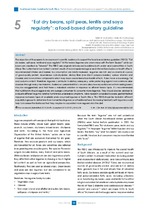| dc.contributor.author | Venter, C.S. | |
| dc.contributor.author | Voster, H.H. | |
| dc.contributor.author | Ochse, R. | |
| dc.contributor.author | Swart, Rina | |
| dc.date.accessioned | 2016-03-03T23:02:45Z | |
| dc.date.available | 2016-03-03T23:02:45Z | |
| dc.date.issued | 2013 | |
| dc.identifier.citation | Venter, C.S. et al. (2013). "Eat dry beans, split peas, lentils and soya regularly": a food-based dietary guideline. South African Journal of Clinical Nutrition, 26 (3): S36-S45 | en_US |
| dc.identifier.issn | 0038-2469 | |
| dc.identifier.uri | http://hdl.handle.net/10566/2085 | |
| dc.description.abstract | The objective of this paper is to review recent scientific evidence to support the food-based dietary guideline (FBDG): “Eat
dry beans, split peas, lentils and soya regularly”. In this review, legumes are synonymous with the term “pulses”, while soy
beans are classified as “oilseeds”. The FBDG was originally introduced to address both under- and overnutrition in South
Africa. The nutrient and non-nutrient content, results of recent epidemiological and intervention studies on health effects,
recommended intakes and barriers to consumption are briefly reviewed. Legumes are rich and economical sources
of good-quality protein, slow-release carbohydrates, dietary fibre (non-starch polysaccharides), various vitamins and
minerals and non-nutritive components which may have several beneficial health effects. Pulses have a low energy, fat
and sodium content. Therefore, legumes contribute to dietary adequacy, while protecting against noncommunicable
diseases through many mechanisms. Evidence is presented that concerns about excessive flatulence from eating beans
may be exaggerated, and that there is individual variation in response to different bean types. It is recommended
that nutritionists should aggressively encourage consumers to consume more legumes. They should also be advised to
evaluate different legume varieties to minimise undesirable symptoms. More research is needed to assess gastrointestinal
responses between types of available and consumed legumes in South Africa. The FBDG should be tested in different
population groups to determine how to maintain legumes as a traditional food. Increasing familiarity with legumes could
help to increase the likelihood that they may be incorporated more regularly into the diet. | en_US |
| dc.language.iso | en | en_US |
| dc.publisher | Medpharm | en_US |
| dc.rights | This journal provides immediate open access to its content on the principle that making research freely available to the public supports a greater global exchange of knowledge. The original article is available at http://www.sajcn.co.za/index.php/SAJCN/article/view/744. This work is licensed under a Creative Commons Attribution-Noncommercial-No Derivative Works 2.5 South Africa License | |
| dc.subject | Food-based dietary guideline (FBDG) | en_US |
| dc.subject | Overnutrition | en_US |
| dc.subject | Undernutrition | en_US |
| dc.subject | Legumes | en_US |
| dc.subject | Diet | en_US |
| dc.title | "Eat dry beans, split peas, lentils and soya regularly": a food-based dietary guideline | en_US |
| dc.type | Article | en_US |
| dc.privacy.showsubmitter | false | |
| dc.status.ispeerreviewed | true | |
| dc.description.accreditation | Department of HE and Training approved list | en_US |

